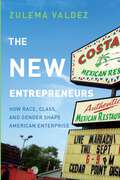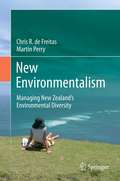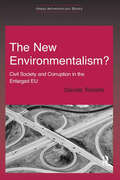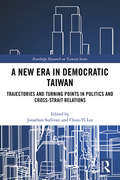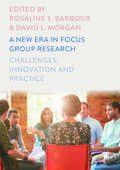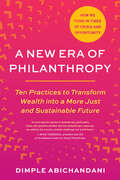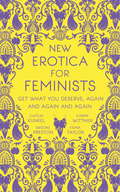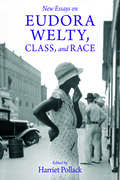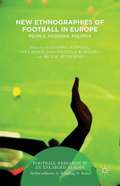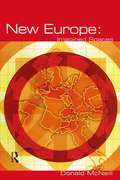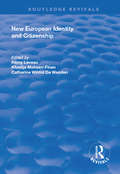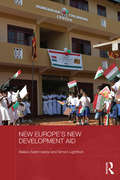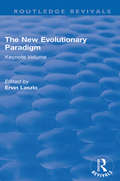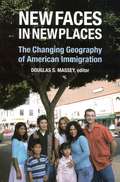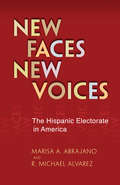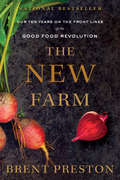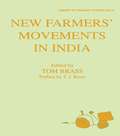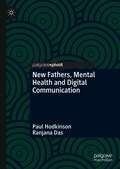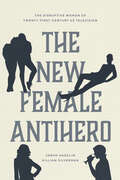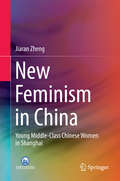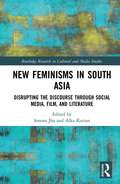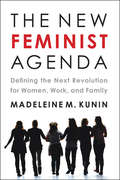- Table View
- List View
The New Entrepreneurs: How Race, Class, and Gender Shape American Enterprise
by Zulema ValdezFor many entrepreneurs, the American Dream remains only partially fulfilled. Unequal outcomes between the middle and lower classes, men and women, and Latino/as, whites, and blacks highlight continuing inequalities and constraints within American society. With a focus on a diverse group of Latino entrepreneurs, this book explores how class, gender, race, and ethnicity all shape Latino entrepreneurs' capacity to succeed in business in the United States. Bringing intersectionality into conversation with theories of ethnic entrepreneurship, Zulema Valdez considers how various factors create, maintain, and transform the social and economic lives of Latino entrepreneurs. While certain group identities may impose unequal, if not discriminatory, starting positions, membership in these same social groups can provide opportunities to mobilize resources together. Valdez reveals how Latino entrepreneurs-as members of oppressed groups on the one hand, yet "rugged individualists" striving for the American Dream on the other-work to recreate their own positions within American society.
New Environmentalism
by Chris R. de Freitas Martin PerryThis book explains the role of New Zealand's environmental agencies and regulatory legislation, taking in the impact of international agreements and treaties. It traces the fortunes of sustainable policy approaches and analyzes the activities of the public agencies charged with managing the environment. Moving on to a detailed thematic status report on New Zealand's environment, it examines rural, freshwater, coastal, oceanic, atmospheric and urban zones. Finally, chapters detail public perceptions and normative environmental values as well as the depth of business commitment to environmental responsibility. An ideal introduction to the topic for a diverse range of scholars, the book eschews any specific theoretical framework in charting the recent evolution, current operation and future trajectory of environmentalism in New Zealand. It backs strategic advice with both social and ecological data, and raises questions over the country's reputation for greenness at the same time as recognizing its numerous achievements. With neat summaries of key issues at the end of each chapter, expansive guidance on further reading, and a multitude of examples ideal for classroom debate, this volume gives us an informed, objective, and wide-ranging appraisal on a topic of increasing centrality in the policy debate.
The New Environmentalism?: Civil Society and Corruption in the Enlarged EU (Urban Anthropology)
by Davide TorselloDrawing on rich ethnographic work in both Eastern and Western Europe, The New Environmentalism? presents a range of case studies to explore the impact of corruption in EU-funded structural development projects. With detailed analyses of the forms and contexts of environmentalism, the book reveals the manner in which corruption is generated by the planning and implementation procedures of the projects, demonstrating in each case that environmental movements emerge as by-products of these processes, using corruption as part of a discourse employed in support of their action against political (regional and state) institutions, as well as to communicate their goals to local citizens. Shedding light on the ways in which revelations about corruption are adopted as a means to fostering civic participation in environmental movements and influencing institutional trust, this book contributes to our understanding of the loss of legitimacy and trust in local and global political institutions. Comparative in approach, The New Environmentalism? provides new insights into the emergence of strong civic movements at local and trans-local levels, in resistance to citizens' sense of increasing alienation from political participation and decision making. As such, it will be of interest to anthropologists, sociologists and political scientists concerned with questions of legitimacy, corruption and activism.
A New Era in Democratic Taiwan: Trajectories and Turning Points in Politics and Cross-Strait Relations (Routledge Research on Taiwan Series)
by Jonathan Sullivan Chun-Yi LeeIn January 2016, Taiwan’s former authoritarian ruler, the KMT, the Nationalist Party of China, lost control of both the presidency and the legislature. Having led the democratization process in Taiwan during the 1980s, it maintained a winning coalition among big business, the public sector, green-collar workers and local factions. Until now. A New Era in Democratic Taiwan identifies past, present and future trajectories in party politics and state-society relations in Taiwan. Providing a comprehensive examination of public opinion data, it sheds light on significant changes in the composition of political attitudes among the electorate. Through theoretical and empirical analyses, this book also demonstrates the emergence of a ‘new’ Taiwanese identity during the transition to democracy and shows how a diffusion of interests in society has led to an opening for niche political organizations. The result, it argues, is a long-term challenge to the ruling parties. As the first book to evaluate Taiwan’s domestic and international circumstances after Tsai’s election in 2016, this book will be useful for students and scholars of Taiwan Studies and cross-Strait relations, as well as Asian politics more generally.
A New Era in Focus Group Research: Challenges, Innovation and Practice
by Rosaline S. Barbour David L. MorganThis volume provides a critical approach to using focus groups, examining how focus groups have been utilized to research a diverse set of research questions covering a broad spectrum of substantive fields. The collection acknowledges the tensions between different research traditions, disciplinary emphases, funding climates, cultural, political, and ethical contexts, and the ever-changing policy backdrop. Contributors to this book encourage researchers to question and surmount disciplinary and terminological labels and disputes in order to capitalize on the full potential of focus groups, to illuminate the complex collaborative processes involved in forming, debating, contesting, and revising opinions; making decisions; and forging identities. The four sections that comprise this collection address, respectively, using focus groups in novel contexts; employing focus groups in mixed methods research designs; innovations in generating focus group data; and new theoretical developments. A New Era in Focus Group Research will be of interest to students and scholars across disciplines as well as focus group practitioners outside of academia.
A New Era of Philanthropy: Ten Practices to Transform Wealth into a More Just and Sustainable Future-- How we fund in times of crisis and opportunity
by Dimple Abichandani&“A must-read for anyone in philanthropy, particularly those who question whether and how philanthropic resources can address the current, complex challenges our world faces.&” —Nick Tedesco, president and chief executive officer of the National Center for Family Philanthropy A blueprint for how wealth can be transformed into a more just and sustainable future in times of rapid change and crisis.On the cusp of the greatest wealth transfer in history—with $84 trillion dollars moving between generations in the next 20 years—this book explores how philanthropy can be transformative, and transformed.Can philanthropy be an anti-racist, feminist, relational, and joyful expression of solidarity?This book argues that it not only can be—for the future we seek, and for philanthropy to achieve its greatest impact, it must be.Nationally recognized philanthropic leader Dimple Abichandani revolutionizes the precepts of modern philanthropy. Offering 10 provocative practice shifts, A New Era of Philanthropy engages readers with fresh answers to the question of how philanthropy can meet this high-stakes moment—from reimagining governance to aligning investments to crisis funding and beyond.Abichandani highlights paradigm shifts that model the way forward, moving beyond critique into real transformation, with relatable stories about funders who are forging a new era of philanthropy.A New Era of Philanthropy picks up where key books like Decolonizing Wealth and Winners Take All leave off, offering a guide for donors, foundations, and non-profit leaders navigating philanthropy in urgent times. Clear-eyed, hopeful, and responsive to the moment, this book helps us reimagine the purpose and norms of modern philanthropy. It is an invitation to all of us who believe these resources can contribute to a more just future: start here.
New Erotica for Feminists: The must-have book for every hot and bothered feminist out there
by Caitlin Kunkel Brooke Preston Fiona Taylor Carrie WittmerHe calls me into his office and closes the door... to promote me. He promotes me again and again. I am wild with ecstasy.Your boss gives you a pay rise, the hotshot producer recognises your talents, the pizza delivery guy hopes you've got a box-set to watch with your extra-large pizza. Prepared to be satisfied...at last.Sometimes a plumber is just a plumber. Get what you really want this year with dozens of literary quickies to tantalise and titillate even the most world-weary feminist.From four brilliant women with their finger on the pulse comes a wickedly funny, provocative and subversive response to #metoo and Time's Up.
New Essays on Eudora Welty, Class, and Race (Critical Perspectives on Eudora Welty)
by Harriet PollackContributions by Jacob Agner, Susan V. Donaldson, Sarah Gilbreath Ford, Stephen M. Fuller, Jean C. Griffith, Ebony Lumumba, Rebecca Mark, Donnie McMahand, Kevin Murphy, Harriet Pollack, Christin Marie Taylor, Annette Trefzer, and Adrienne Akins Warfield The year 2013 saw the publication of Eudora Welty, Whiteness, and Race, a collection in which twelve critics changed the conversation on Welty’s fiction and photography by mining and deciphering the complexity of her responses to the Jim Crow South. The thirteen diverse voices in New Essays on Eudora Welty, Class, and Race deepen, reflect on, and respond to those seminal discussions. These essays freshly consider such topics as Welty’s uses of African American signifying in her short stories and her attention to public street performances interacting with Jim Crow rules in her unpublished photographs. Contributors discuss her adaptations of gothic plots, haunted houses, Civil War stories, and film noir. And they frame Welty’s work with such subjects as Bob Dylan’s songwriting, the idea and history of the orphan in America, and standup comedy. They compare her handling of whiteness and race to other works by such contemporary writers as William Faulkner, Richard Wright, Toni Morrison, Chester Himes, and Alice Walker. Discussions of race and class here also bring her masterwork The Golden Apples and her novel Losing Battles, underrepresented in earlier conversations, into new focus. Moreover, as a group these essays provide insight into Welty as an innovative craftswoman and modernist technician, busily altering literary form with her frequent, pointed makeovers of familiar story patterns, plots, and genres.
New Ethnographies of Football in Europe: People, Passions, Politics (Football Research In An Enlarged Europe)
by Nina Szogs Alexandra Schwell Malgorzata Z. Kowalska Michal BuchowskiFootball has emerged as an important symbolic field through which various social, cultural, political, economic, and historical dimensions and antagonisms are negotiated. This volume covers a variety of themes illuminating the multiple ways that football impacts on people's everyday lives. Using anthropological research methods and data collected from ethnographic fieldwork, the contributors scrutinize not only the social fields of football fans and the specific socio-cultural contexts in which they are embedded, but also other actors beyond the pitch, and the possibilities for both agency and subversion. Taking into account processes of Europeanization, globalization, commercialization and migration, the collection offers fresh insights into fan identity formations and practices and highlights the importance of anthropology's self-reflexive and actor-centred perspective.
New Europe: Imagined Spaces
by Donald McNeillNew Europe: Imagined Spaces traces the radical transformation of European places and spaces over the last two decades. Instead of the familiar 'schoolbook' map of a Europe of nation-states, the book unpacks the differing imaginations of European identity in recent years. Taking as its central problem the fluid nature of cultural and political identity, it moves firmly away from - and calls into question - the perspective of the nation-state as the primary source of imagined identity for Europeans.The book contributes to key debates, such as the emerging Europe of the Regions and the return of the city-state, examines the 'rebranding' of the nation-state and explores the impact of 'Europeanisation' on existing place identity. Emphasising mobility and movement, the chapters explore borderlands and travel, and also include a detailed discussion of the 'everyday life' of Europeans. Throughout, iconic images of contemporary Europe are invoked: Eurodisney, the Reichstag, Barcelona's Ramblas and the Bilbao Guggenheim, and the way in which mundane artefacts and practices such as football, walking, cars, food, passports and the Euro help construct identity is considered. New Europe: Imagined Spaces adopts a multidisciplinary approach to studying Europe, providing students with an exploration of contemporary European space and place identity.
New European Identity and Citizenship (Routledge Revivals Ser.)
by RÉMY LEVEAU, KHADIJA MOHSEN-FINAN AND CATHERINE WIHTOL DE WENDENThis title was first published in 2002. This study, undertaken with the support of the Ford Foundation under the scientific leadership of Khadija Mohsen-Finan, Remy Leveau and Catherine Wihtol de Wenden considers the new forms of citizenship and identity that have emerged within the settlements of immigrant populations in various countries in Europe. Through their claims to citizenship, shifting religious identities and by occupying the high ground both locally and at European level, these communities challenge long standing citizenship models and give full meaning to the concepts of supranational European citizenship. The contributors question whether such European citizenship will include all residents of Europe or whether it will serve to increase the exclusion felt by certain groups of migrants. In particular the contributors examine the implications of three emerging citizenship trends - the impact of the demand for Islam; the emergence of undocumented migrants and their inclusion in an increasingly stratified society; and finally, the rising tide of ordinary or political refugees who are challenging European citizenship on their own terms.
New Europe's New Development Aid (BASEES/Routledge Series on Russian and East European Studies)
by Simon Lightfoot Balázs Szent-IványiThis book examines the international development policies of five East Central European new EU member states, the Czech Republic, Hungary, Poland, Slovakia and Slovenia. These countries turned from being aid recipients to donors after the turn of the millennium in the run-up to EU accession in 2004. The book explains the evolution subsequent to EU accession and current state of foreign aid policies in the region and the reasons why these deviate from many of the internationally agreed best practices in development cooperation. It argues that after the turn of the millennium, a 'Global Consensus' has emerged on how to make foreign aid more effective for development. A comparison between the elements of the Global Consensus and the performance of the five countries reveals that while they have generally implemented little of these recommendations, there are also emerging differences between the countries, with the Czech Republic and Slovenia clearly aspiring to become globally responsible donors. Building on the literatures on foreign policy analysis, international socialization and interest group influence, the book develops a model of foreign aid policy making in order to explain the general reluctance of the five countries in implementing international best practices, and also the differences in their relative performance.
The New Evolutionary Paradigm: Keynote Volume (Routledge Revivals)
by Ervin LaszloOriginally published in 1991, The New Evolutionary Paradigm provides an innovative and cross disciplinary look at evolution. While Darwin’s theory of evolution was originally restricted to the life sciences, in recent years the same principles have been applied successfully to historical, social and natural sciences. The papers included in The New Evolutionary Paradigm analyse the facts, observations, and accumulated data from the significance of a general evolution theory cannot be overemphasised; a new understanding of the cosmos and man’s relationship to it could lead to the systemization of the irreversible change that takes place in society and nature. This book will appeal to scientists, sociologists and those interested in transdisciplinary evolution theories.
New Faces in New Places: The Changing Geography of American Immigration
by Douglas S. MasseyBeginning in the 1990s, immigrants to the United States increasingly bypassed traditional gateway cites such as Los Angeles and New York to settle in smaller towns and cities throughout the nation. With immigrant communities popping up in so many new places, questions about ethnic diversity and immigrant assimilation confront more and more Americans. New Faces in New Places, edited by distinguished sociologist Douglas Massey, explores today’s geography of immigration and examines the ways in which native-born Americans are dealing with their new neighbors. Using the latest census data and other population surveys, New Faces in New Places examines the causes and consequences of the shift toward new immigrant destinations. Contributors Mark Leach and Frank Bean examine the growing demand for low-wage labor and lower housing costs that have attracted many immigrants to move beyond the larger cities. Katharine Donato, Charles Tolbert, Alfred Nucci, and Yukio Kawano report that the majority of Mexican immigrants are no longer single male workers but entire families, who are settling in small towns and creating a surge among some rural populations long in decline. Katherine Fennelly shows how opinions about the growing immigrant population in a small Minnesota town are divided along socioeconomic lines among the local inhabitants. The town’s leadership and professional elites focus on immigrant contributions to the economic development and the diversification of the community, while working class residents fear new immigrants will bring crime and an increased tax burden to their communities. Helen Marrow reports that many African Americans in the rural south object to Hispanic immigrants benefiting from affirmative action even though they have just arrived in the United States and never experienced historical discrimination. As Douglas Massey argues in his conclusion, many of the towns profiled in this volume are not equipped with the social and economic institutions to help assimilate new immigrants that are available in the traditional immigrant gateways of New York, Los Angeles, and Chicago. And the continual replenishment of the flow of immigrants may adversely affect the nation’s perception of how today’s newcomers are assimilating relative to previous waves of immigrants. New Faces in New Places illustrates the many ways that communities across the nation are reacting to the arrival of immigrant newcomers, and suggests that patterns and processes of assimilation in the twenty-first century may be quite different from those of the past. Enriched by perspectives from sociology, anthropology, and geography New Faces in New Places is essential reading for scholars of immigration and all those interested in learning the facts about new faces in new places in America.
New Faces, New Voices: The Hispanic Electorate in America
by Marisa A. Abrajano R. Michael AlvarezA comprehensive look at Hispanic voters in the United StatesMaking up 14.2 percent of the American population, Hispanics are now the largest minority group in the United States. Clearly, securing the Hispanic vote is more important to political parties than ever before. Yet, despite the current size of the Hispanic population, is there a clear Hispanic politics? Who are Hispanic voters? What are their political preferences and attitudes, and why? The first comprehensive study of Hispanic voters in the United States, New Faces, New Voices paints a complex portrait of this diverse and growing population.Examining race, politics, and comparative political behavior, Marisa Abrajano and R. Michael Alvarez counter the preconceived notion of Hispanic voters as one homogenous group. The authors discuss the concept of Hispanic political identity, taking into account the ethnic, generational, and linguistic distinctions within the Hispanic population. They compare Hispanic registration, turnout, and participation to those of non-Hispanics, consider the socioeconomic factors contributing to Hispanics' levels of political knowledge, determine what segment of the Hispanic population votes in federal elections, and explore the prospects for political relationships among Hispanics and non-Hispanics. Finally, the authors look at Hispanic opinions on social and economic issues, factoring in whether these attitudes are affected by generational status and ethnicity.A unique and nuanced perspective on the Hispanic electoral population, New Faces, New Voices is essential for understanding the political characteristics of the largest and fastest growing group of minority voters in the United States.
The New Farm: Our Ten Years on the Front Lines of the Good Food Revolution
by Brent PrestonThe inspiring and sometimes hilarious story of a family that quit the rat race and left the city to live out their ideals on an organic farm, and ended up building a model for a new kind of agriculture.You know those books where the city folks move to the country and have all kinds of crazy misadventures? Where the barnyard is a place of bucolic harmony and each passing season brings the author closer to understanding his proper place in the natural order? You know those books where the primary objective is not so much farming, but writing about farming? This isn’t that kind of book. It’s true that Brent Preston and Gillian Flies did leave the city and move to the country, and they did make a lot of stupid mistakes, some of which are pretty funny in hindsight. But their goal from the beginning was to build a real farm, one that would sustain their family, heal their environment, and nourish their community. It was a goal that was achieved not through bucolic self-reflection, but through a decade of grinding toil and perseverance. Told with humour and heart in Preston’s unflinchingly honest voice, The New Farm is the story of one family’s transition from die-hard urbanites to bona fide farmers and passionate advocates for a more just and sustainable food system. It’s the story of how a couple of young professionals learned not just how to grow food, but how to succeed at the business of farming. And it’s the story of how a small, sustainable, organic farm ended up providing not just a livelihood, but a happy, meaningful and fulfilling way of life.
New Farmers' Movements in India
by Tom BrassThe essays in this collection focus on the reasons for and background to the emergence during the 1980s of the new farmers' movements in India. In addition to a more general consideration of the economic, political and theoretical dimensions of this development, there are case studies which cover the farmer's movements in Maharashtra, Uttar Pradesh, Punjab and Karnataka.
New Fathers, Mental Health and Digital Communication
by Paul Hodkinson Ranjana DasThis book explores the experiences of new fathers struggling with mental health difficulties and focuses on the role of digital media as part of their approaches to coping. Hodkinson and Das show how the ways new fathers are positioned by society can make it hard for them to recognize their struggles as legitimate, or reach out for help. The book explores a range of different uses of digital communication by struggling fathers, from selective forms of disconnection, to the seeking out of online information or support. The authors highlight the significance even of the smallest digital acts as part of coping journeys and outline the development of tentative or hidden attempts to reach out for help, and the potential for supportive digital interactions to emerge. The book’s conclusions highlight the agentic possibilities digital media might offer for struggling new fathers, while emphasizing the need for improvements in how they are prepared and supported by health services and others.
The New Female Antihero: The Disruptive Women of Twenty-First-Century US Television
by Sarah Hagelin Gillian SilvermanThe New Female Antihero examines the hard-edged spies, ruthless queens, and entitled slackers of twenty-first-century television. The last ten years have seen a shift in television storytelling toward increasingly complex storylines and characters. In this study, Sarah Hagelin and Gillian Silverman zoom in on a key figure in this transformation: the archetype of the female antihero. Far from the sunny, sincere, plucky persona once demanded of female characters, the new female antihero is often selfish and deeply unlikeable. In this entertaining and insightful study, Hagelin and Silverman explore the meanings of this profound change in the role of women characters. In the dramas of the new millennium, they show, the female antihero is ambitious, conniving, even murderous; in comedies, she is self-centered, self-sabotaging, and anti-aspirational. Across genres, these female protagonists eschew the part of good girl or role model. In their rejection of social responsibility, female antiheroes thus represent a more profound threat to the status quo than do their male counterparts. From the devious schemers of Game of Thrones, The Americans, Scandal, and Homeland, to the joyful failures of Girls, Broad City, Insecure, and SMILF, female antiheroes register a deep ambivalence about the promises of liberal feminism. They push back against the myth of the modern-day super-woman—she who “has it all”—and in so doing, they give us new ways of imagining women’s lives in contemporary America.
The New Female Antihero: The Disruptive Women of Twenty-First-Century US Television
by Sarah Hagelin Gillian SilvermanThe New Female Antihero examines the hard-edged spies, ruthless queens, and entitled slackers of twenty-first-century television. The last ten years have seen a shift in television storytelling toward increasingly complex storylines and characters. In this study, Sarah Hagelin and Gillian Silverman zoom in on a key figure in this transformation: the archetype of the female antihero. Far from the sunny, sincere, plucky persona once demanded of female characters, the new female antihero is often selfish and deeply unlikeable. In this entertaining and insightful study, Hagelin and Silverman explore the meanings of this profound change in the role of women characters. In the dramas of the new millennium, they show, the female antihero is ambitious, conniving, even murderous; in comedies, she is self-centered, self-sabotaging, and anti-aspirational. Across genres, these female protagonists eschew the part of good girl or role model. In their rejection of social responsibility, female antiheroes thus represent a more profound threat to the status quo than do their male counterparts. From the devious schemers of Game of Thrones, The Americans, Scandal, and Homeland, to the joyful failures of Girls, Broad City, Insecure, and SMILF, female antiheroes register a deep ambivalence about the promises of liberal feminism. They push back against the myth of the modern-day super-woman—she who “has it all”—and in so doing, they give us new ways of imagining women’s lives in contemporary America.
The New Female Antihero: The Disruptive Women of Twenty-First-Century US Television
by Sarah Hagelin Gillian SilvermanThe New Female Antihero examines the hard-edged spies, ruthless queens, and entitled slackers of twenty-first-century television. The last ten years have seen a shift in television storytelling toward increasingly complex storylines and characters. In this study, Sarah Hagelin and Gillian Silverman zoom in on a key figure in this transformation: the archetype of the female antihero. Far from the sunny, sincere, plucky persona once demanded of female characters, the new female antihero is often selfish and deeply unlikeable. In this entertaining and insightful study, Hagelin and Silverman explore the meanings of this profound change in the role of women characters. In the dramas of the new millennium, they show, the female antihero is ambitious, conniving, even murderous; in comedies, she is self-centered, self-sabotaging, and anti-aspirational. Across genres, these female protagonists eschew the part of good girl or role model. In their rejection of social responsibility, female antiheroes thus represent a more profound threat to the status quo than do their male counterparts. From the devious schemers of Game of Thrones, The Americans, Scandal, and Homeland, to the joyful failures of Girls, Broad City, Insecure, and SMILF, female antiheroes register a deep ambivalence about the promises of liberal feminism. They push back against the myth of the modern-day super-woman—she who “has it all”—and in so doing, they give us new ways of imagining women’s lives in contemporary America.
New Femininities
by Rosalind Gill Christina ScharffThis collection of original essays looks at the way in which experiences and representations of femininity are changing, and explores the possibilities for producing 'new' femininities in the twenty-first century. The volume includes a Preface by leading feminist scholar Angela McRobbie.
New Feminism in China
by Jiaran ZhengThis book is based on rich empirical data and findingsconcerning the lives, perceptions and ambitions of young middle-class femalegraduates, thus providing essential insights into the lives and viewpoints of apreviously unresearched group in China from a feminist scholarly perspective. The study shows how the lives of young women and debates over youthfulfemininity lie at the very heart of modern Chinese history and society. With acentral focus on women's issues, the book's ultimate goal is to enable Westernreaders to better understand the changing ideologies and the overall socialdomain of China under the leadership of President Xi. The empirical datapresented includes interviews and group discussions, as well as illustrations,tables and images collected during a prolonged period of fieldwork. Theinsights shared here will facilitate cross-cultural communication with bothWestern feminist academics and readers who are sensitive to different cultures.
New Feminisms in South Asian Social Media, Film, and Literature: Disrupting the Discourse (Routledge Research in Cultural and Media Studies)
by Sonora Jha Alka KurianThis book is a study of the resurgence and re-imagination of feminist discourse on gender and sexuality in South Asia as told through its cinematic, literary, and social media narratives. It brings incisive and expert analyses of emerging disruptive articulations that represent an unprecedented surge of feminist response to the culture of sexual violence in South Asia. Here scholars across disciplines and international borders chronicle the expressions of a disruptive feminist solidarity in contemporary South Asia. They offer critical investigations of these newly complicated discourses across narrative forms – hashtag activism on Facebook and Twitter, the writings of diasporic writers such as Jhumpa Lahiri, Bollywood films like Mardaani, feminist Dalit narratives in the fiction of Bama Faustina, social media activism against rape culture, journalistic and cinematic articulations on queer rights, state censorship of "India’s Daughter", and feminist film activism in Bangladesh, Kashmir, Nepal, and Sri Lanka.
The New Feminist Agenda: Defining the Next Revolution for Women, Work, and Family
by Madeleine M. KuninFeminists opened up thousands of doors in the 1960s and 1970s, but decades later, are U.S. women where they thought they would be? The answer, it turns out, is a resounding no. Surely there have been gains. Women now comprise nearly 60 percent of college undergraduates and half of all medical and law students. They have entered the workforce in record numbers, making the two wage earner family the norm. But combining a career and family turned out to be more complicated than expected. While women changed, social structures surrounding work and family remained static. Affordable and high quality child care, paid family leave, and equal pay for equal work remain elusive for the vast majority of working women. In fact, the nation has fallen far behind other parts of the world on the gender equity front. We lag behind more than seventy countries when it comes to the percentage of women holding elected federal offices. Only 17 percent of corporate boards include women members. And just 5 percent of Fortune 500 companies are led by women. It is time, says the author, to change all that. Looking back over five decades of advocacy, she analyzes where progress stalled, looks at the successes of other countries, and charts the course for the next feminist revolution, one that mobilizes women, and men, to call for the kind of government and workplace policies that can improve the lives of women and strengthen their families.
